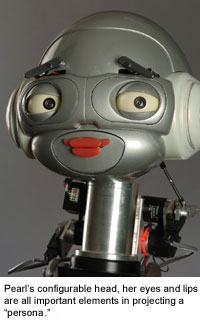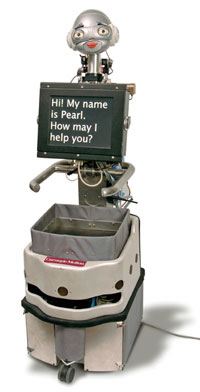Pearl the NurseBot: The Softer Side of Technology
What would you like to have a robot help out with around the house?

For the rising tide of elderly people, having a reliable assistant who can help with daily tasks and provide a level of companionship could be the difference between being able to live independently and being forced into a nursing home. It would also change the way health care is delivered, so these seniors could remain in their homes and enjoy a better quality of life for as long as possible.
These are the stakes for robots like Pearl the NurseBot.
Researchers are exploring important issues about what functions a robot assistant could provide to senior citizens—as well as learning more about the way people interact with a robot when they introduce more “human-like” characteristics.
Pearl is a prototype personal mobile robotic assistant that can recognize speech, follow patients around and communicate via touch screen. She is being groomed to remind seniors to take their medication, see the doctor and keep from getting lost. She could also serve as a “telepresence” for remote checkups with caregivers.
But, Pearl’s ultimate success will depend on whether people just plain like being around her.
To that end, a multidisciplinary team of roboticists, social scientists and interaction designers has drawn on theories of emotion from cognitive science and the principles of aesthetics to explore what happens when human characteristics are added—or taken away—from Pearl’s “persona.”
“We certainly don’t know what the ‘right level’ of human likeness may be, but we do want to find that out,” said one researcher.
Pearl has a vocabulary of expressions intended to make her both more engaging and more efficient. Pearl’s appealing look and her ability to communicate and navigate seems to prompt many people to see her as a character—or even a "real" creature.
Initially, researchers focused on enabling Pearl to move from one place to another, and to have a conversation using her touch screen. Today, researchers in Carnegie Mellon’s People and Robots Laboratory continue to make Pearl friendlier.

Appearance has a strong impact on a person’s expectations. Researchers want to learn whether facial characteristics will factor into the emotional reaction of people who interact with her. Pearl’s configurable head, the size and spacing of her eyes and the shape of her lips are all important elements in projecting a “persona.” The team is studying people’s responses to a robot’s perceived gender by changing Pearl’s lips and voice.
Some observers noted that having a more expressive countenance seems to be an advantage, but if the robot becomes “too humanlike, it can creep people out.”
The question of “how human should a robot look” has great implications on how effective and accepted robotic assistants can be.
As the world’s aging population puts increasing strain on health-care delivery and more and more families face difficult choices when trying to help their aging relatives, the success of robots like Pearl may have a tremendous impact on the well-being of millions. But people must be able to trust them and view them as real assistants, not family pets. At the same time, humanoid robots can prompt users to believe they can do even more than they are able to deliver.
The aspiration to create a robotic assistant that can make people’s lives healthier and fuller demands breakthroughs in understanding both technology and humanity.
At Carnegie Mellon, the People and Robots Project is being pursued with amazing zeal. As one researcher put it, “we have succeeded in helping people to live longer. Now we need to help them live better.”
Related Links:
The Nursebot Project
Social Robots Project



